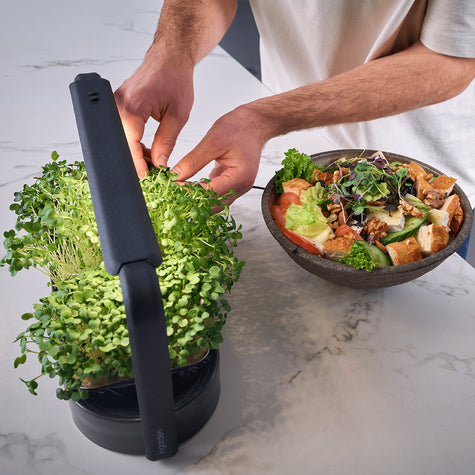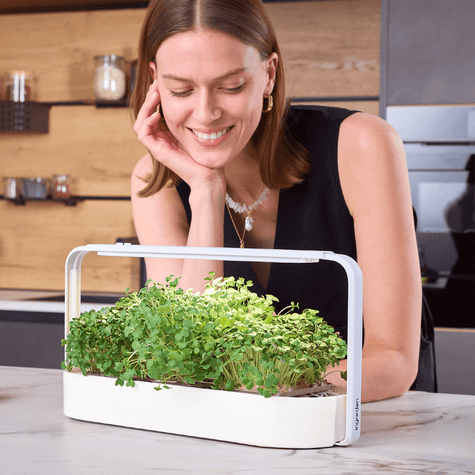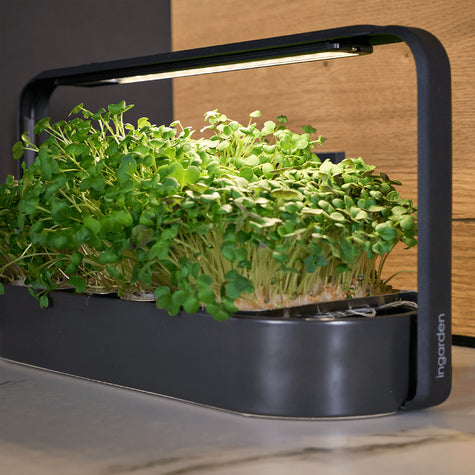It starts with a simple kitchen experiment: You place a few seeds on damp kitchen paper, wait a few days – and suddenly fresh greens sprout. A familiar sight from childhood. Most of us know this little burst of freshness as cress , easy and quick to grow. But now it has a new green star to contend with: microgreens .
What looks similar at first glance turns out, upon closer inspection, to be more complex, more diverse – and yes, sometimes more expensive. But is the term " microgreens " really just a chic rebranding of the familiar cress ?
In this article, we'll take you on a short journey into the world of young plants – and show you why microgreens are more than just expensive cress.
What are microgreens?
Microgreens are the seedlings of various vegetables and herbs, typically harvested 7 to 14 days after germination – precisely when the first true leaves have developed. Botanically speaking, they are therefore older than sprouts but younger than baby greens. This makes them particularly nutrient-rich and intensely flavorful.
The term "microgreens" first appeared in the 1980s in top Californian restaurants. Today, they are no longer just a trend on gourmet plates, but an integral part of modern, health-conscious nutrition. Particularly popular varieties include:
-
Broccoli microgreens : mild, contains, among other things, sulforaphane
-
Radish microgreens : peppery and fresh, with vitamin E and vitamin K1
-
Arugula microgreens : spicy and particularly aromatic, contains iron and manganese
-
Red cabbage microgreens : rich in antioxidants, vibrant purple in color
What surprises many is that studies show microgreens can contain up to 40 times more vitamins and phytochemicals than their mature counterparts, depending on the variety. For example, broccoli in its micro-stage contains particularly high levels of sulforaphane – a compound considered potentially protective in cancer research .
Microgreens are also state-of-the-art in terms of cultivation: instead of soil, many systems now use hydroponic technologies – a water-based, nutrient-rich growing medium that is particularly clean, space-saving and efficient.
What is cress?
Cress , or more precisely garden cress (Lepidium sativum) , is a true classic – and probably the first plant many children ever encounter when gardening. No wonder: the seeds germinate quickly, require little care, and can even be grown on cotton wool or kitchen paper. It's ready to harvest after just three to four days – a quick sense of accomplishment for young and old alike.
The taste of cress is unmistakable: sharp, slightly bitter, with a mustard-like note. This intensity is due to the mustard oil glycosides it contains , which serve as a natural defense mechanism in the plant world – but can exhibit antibacterial properties in humans. Cress also contains vitamin C, iron, and folic acid, although in smaller quantities than in many microgreens.
Microgreens vs. Cress – The 3 most important differences
At first glance, microgreens and cress appear almost identical: both are small, fresh, and ready to harvest within a few days. However, a closer look reveals that they differ significantly in three key aspects.
1. Plant varieties & diversity
The term cress The term "cress " almost always refers to a single plant: garden cress . While there are related species like watercress or nasturtium , these are not what we mean when we say we're "growing cress" at home. In practice, the selection remains limited – both in terms of taste and appearance.
Microgreens, on the other hand, are a general term for the sprouts of many vegetables: broccoli , red cabbage , kale , arugula , mustard , radish , bok choy, sunflower, garlic – the list goes on. This diversity allows for the combination of different flavors, textures, and colors – from mild to spicy, from grass green to deep purple.
2. Growth period & care
Cress is easy to grow. A few seeds, some water, daylight – that's it. It grows on cotton wool, kitchen paper, or in soil, but needs daily moistening. However, the substrate dries out easily, which can lead to uneven growth. Harvesting is also often rather imprecise – cutting with scissors directly over damp paper isn't for everyone.
Microgreens take a few days longer to mature, depending on the variety (typically 7–14 days), but are more robust. Cultivation is almost effortless, especially in a hydroponic gardening system where the plants are automatically watered and grow on biofiber pads. No watering, no spilled soil, no kitchen mess – and a bountiful harvest at the end.
3. Nutrients & Flavor Complexity
This is where cress and microgreens finally diverge: cress is healthy – no question about it. It contains, among other things, mustard oils, vitamin C, iron, and some folic acid, and its essential oils have a mild antibacterial effect.
But microgreens often go significantly further in terms of nutrient density. Studies from the University of Maryland have shown that microgreens – depending on the variety and growing conditions – have up to 40 times higher concentrations of vitamins, antioxidants, and polyphenols than their mature counterparts. Broccoli and red cabbage microgreens, in particular, have stood out in studies as nutrient-rich top performers.
Microgreens also offer a wide range of flavors: from sweet and nutty to strong and spicy. A mix of, for example, radish, arugula, and red cabbage microgreens provides a complex flavor profile – perfect for bowls, sandwiches, or smoothies.
Similarities: Why both are green, healthy, and popular
Despite all the differences, microgreens and cress also have some things in common – and that's exactly what makes them so popular:
1. Fresh produce for growing yourself
Both can be grown directly in the kitchen. This not only ensures freshness on the plate, but also a feeling of control over what you eat. Especially in times when many people are looking for regional, pesticide-free food, microgreens and cress offer a wonderful solution for home use.
2. Sustainable lifestyle
Whether in a city apartment or a tiny house – microgreens and cress require hardly any space, no single-use plastic, and no transport over hundreds of kilometers. Water consumption is minimal, especially in hydroponic systems.
3. Getting started with urban gardening
Both cress and microgreens offer an easy entry point into urban gardening. They demonstrate that self-sufficiency is possible even in the smallest of spaces – with little effort, but a high impact on health and well-being.
Question: Are microgreens really "just" expensive cress?
This question comes up frequently – in forums, on social media, in recipe comments. And yes: at first glance, microgreens seem like a luxurious offshoot of familiar cress – with fancy names, vibrant colors, and a higher price. But let's take a closer look:
Production costs
Microgreens require controlled conditions, special seeds, and often a clean and nutrient-rich medium. In hydroponic indoor gardens, the technology behind the scenes—automatic watering, LEDs, sustainable biofiber pads—is designed for optimal results. This quality comes at a price, but it also delivers measurable added value: yield, freshness, and nutrients.
Nutrient power instead of mass
Cress is inexpensive, no question. But for those who want to specifically incorporate certain active ingredients (such as sulforaphane or certain antioxidants) into their diet, microgreens offer exactly that – in concentrated form. Even a small portion can make a significant contribution to micronutrient intake.
Variety & Experience
Last but not least, the experience is crucial: While growing cress is often a monotonous, albeit familiar, routine, cultivating microgreens offers a true food adventure. You discover new flavors, get to know your favorite varieties, and actively and creatively shape your meals.
Conclusion: Which suits you better – cress or microgreens?
👩🍳 For traditionalists and minimalists: Cress
If you prefer a minimalist approach, evoke memories of your childhood, and want to add a touch of green to your bread with minimal effort, then cress is perfect for you. It's charming in its simplicity, requires no special techniques, and delivers quick results.
🌿 For the curious, the health-conscious, and food lovers: Microgreens
Microgreens are like the next level in indoor gardening. You can choose from many different varieties, discover new flavors, and do something good for your health at the same time. They offer not only visual and culinary diversity, but also scientifically proven benefits due to their high concentration of micronutrients.
Bonus tip: Start your own indoor garden with ingarden
The ingarden starter set includes everything you need to get started right away:
✅ Organic certified seed pads in varieties such as broccoli, radish or arugula
✅ Automatic watering – you only water once a week
✅ Energy-saving LEDs – perfect light for optimal growth
✅ Stylish design – fits in any kitchen or on the windowsill











